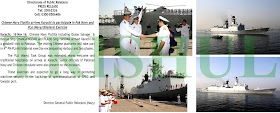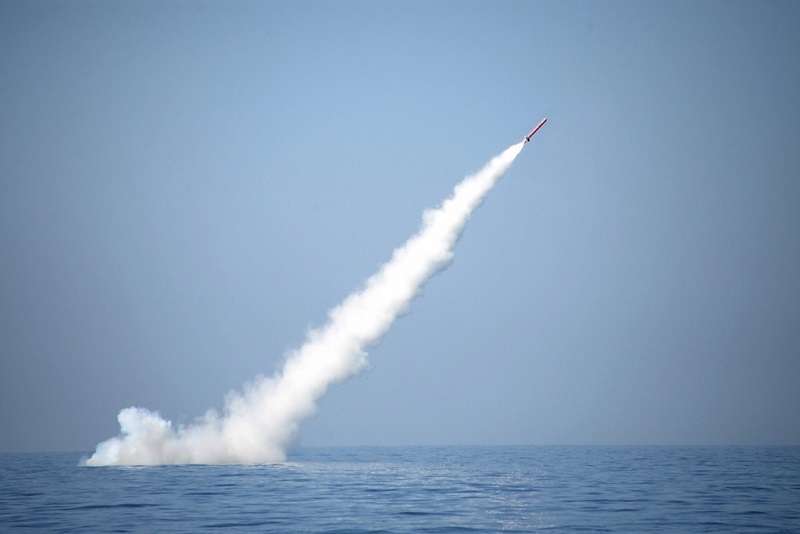Monday, January 9, 2017
A Not-So-Silent War
The mystery surrounding the alleged interception of an Indian Navy (IN) diesel-electric submarine (SSK) on November 16 last year by a Pakistan Navy (PN) P-3C Orion LRMR/ASW aircraft can at last be resolved, thanks to the arrival in Malaysia of a Type 039G1 Song-class SSK (of the South Sea Fleet’s 32nd Submarine Flotilla located at Zhangjiang naval base in Guangdong province) and its accompanying ocean salvage & rescue ship, theType 925-class Chang Xingdao 861 (of the North Sea Fleet’s 1st Combat Support Flotilla), which docked at the Royal Malaysian Navy’s submarine base at Sepanggar Bay in Sabah from January 3 till 7 for picking up perishable supplies and for their crew complements to rest after conducting anti-piracy patrols off the coast of Somalia.

From the above, it can safely be deduced that the Type 039G1 Song-class SSK left its homeport in the South China Sea sometime in mid-October last year accompanied by Chang Xingdao 861 and the Type 054A FFGHandan 579 (built by the Huangpu-based Wenchong Shipbuilding Co Ltd and commissioned on August 16, 2015 with the PLAN’s North Sea Fleet) . These three vessels would surely have been trailed first by the US Navy right up to the Indonesian archipelago, following which an Indian Navy Type 877EKM SSK hailing from either the 8th or 11th Submarine Squadron (homeported at INS Virbahu in Visakhapatnam under the Eastern Naval Command) would have trailed them right up to the western part of the Indian Ocean, following which the trailing would have been continued by a Class 209/Type 1500 SSK of the10th Submarine Squadron (homeported at INS Bajrabahu in Mumbai under the Western Naval Command).
Interestingly, while the PN officially announced on November 16 in its official website that a PLAN Flotilla including the Chang Xingdao 861 and Handan 579 had arrived Karachi on a goodwill visit to Pakistan and would later take part in the 4th PN-PLAN bilateral exercise encompassing harbour and sea phases, the announcement kept quiet about the presence of the Type 039G1 Song-class SSK.

Instead, the PN made a big song-and-dance about an ‘unidentified’ IN SSK being tracked by a PN P-3C Orion since November 12 in international waters south of Karachi, and ultimately culminating in the IN SSJ ‘being forced to snorkel’ some 40nm outside Pakistan’s territorial waters. And this narrative was further spin-woven to showcase the PN’s mastery in undersea warfare against its Indian counterpart. In reality, what transpired was that the IN’s Class 209/Type 1500 SSK had already completed its assigned task (and therefore had no need to stay hidden) after handing over its flotilla shadowing tasking to another Class 209/Type 1500 SSK that had remained undetected in the same area and was subsequently successful (along with a P-8I LRMR/ASW aircraft) in monitoring the 4th PN-PLAN bilateral exercise in the northern Arabian Sea.
Therefore, the presence of a PN P-3C Orion (which was sent to escort the inbound PLAN flotilla to Karachi) over the snorkeling IN Class 209/Type 1500 SSK in international waters was a mere coincidence, and was not by design by any stretch of imagination.
The number of PLAN submarine sorties has approximately quadrupled over the last seven years, with an average of 12 patrols being conducted each year between 2008 and 2015, following on from six in 2007, two 2006 none in 2005. In the Indian Ocean region (IOR), the PLAN has so farcarried out six submarine patrols (all accompanied by Type 925/Type 926 submarine tenders), with the submarines being kept its vessels out at sea for 95 days during each patrol.
The PLAN’s first SSN patrol within the IOR lasted from December 3, 2013 till February 12, 2014. One Type 093 Shang-class boat left Longpo its bastion at Yulin on December 3. Ten days later, on December 13, the SSN reached the Gulf of Aden via the Ombai Wetar Strait near Indonesia. It remained on patrol in the area for nearly two months. Next to follow was the Type 039G1 Song-class SSK ‘Great Wall 329’ of the South Sea Fleet’s 32nd Submarine Flotilla, which later docked at the China-funded Colombo International Container Terminal in Sri Lanka from September 7 to 14, 2014 along with the Type 925-class tender Changxingdao 861. This was followed by a patrol of a Type 093 SSN from December 13, 2014 to February 14, 2015. After its two-month escort mission in the pirate-infested waters of the Gulf of Aden, this SSN returned to its base in Qingdao, Shandong province in April. Next came a S-20/Type 041A Yuan-class SSK 335 from the North Sea Fleet’s 2nd Submarine Flotilla that docked at Pakistan’s Karachi port on May 22, 2015, and was accompanied by the submarine tender Chang Xingdao 861. These two vessels had set sail from Hainan Island on March 31.
In January 2016 a Type 093 SSN was reportedly lurking in waters around the Andaman Sea. The vessel was in international waters and the IN’s P-8Is conducted specific ASW sorties over the Bay of Bengal and Andaman Sea. This SSN was accompanied by three warships that were part of the anti-piracy task force on duty off the coast of Africa, which returned to China after a four month deployment. Yu Manjiang, deputy chief of staff of the PLAN’s South China Sea Fleet, was the commanding officer of this flotilla. On its return journey, the flotilla was docked in Colombo, Sri Lanka, from January 17 to January 21. The anti-piracy escort force departed from the Gulf of Aden on January 3 and first headed for Pakistan. Colombo was its second stop, which was followed by a stopover at Chittagong, Bangladesh on a five-day goodwill visit in late January. Two of these warships (not the SSN) then arrived in India for the international fleet review on February 6/7 at Vishakapatnam. The flotilla comprised the Type 054A guided-missile frigates Liuzhou 573 and Sanya 574 of the South Sea Fleet, and a replenishment tanker, Qinghaihu 885. The Sanya 574 and Qinghaihu 885 arrived at Laem Chabang Port, Thailand, on February 17, 2016 for a five-day goodwill visit. This flotilla returned to a military port in Sanya on the morning of March 8, 2016, after completing 218-day missions and traveling nearly 90,000 nautical miles.
A Type 093 Shang-class SSN (SSN-409) was placed at Karachi in May 2016 with Type 925 submarine tender Yongxingdao 863 of theSouth Sea Fleet. A month later (June 2016) it was crossing through the Malacca Straits off the coast of Singapore along with YunCheng 571 FFG of the South Sea Fleet’s 1st Frigate Group.

From this, it can be deduced that in the years to come, the PLAN will continue with this practice of launching at the very least two annual long-distance patrols—one each by an SSN and SSK—into the IOR. Entry while remaining submerged into the IOR from either the South China Sea or the Pacific Ocean will be made through either the Lombok Strait or the Ombai Wetar Straits astride Indonesia. To logistically support such long-range deployments, China plans to build 18 to 19 overseas strategic supply bases in Djibouti, Yemen, Omen, Kenya, Tanzania, Mozambique, Namibia, Seychelles and Madagascar. In Namibia, China plans to build a naval supply base at Walvis Bay.

The Babur-3 SLCM Bakwaas Exposed
On January 9, 2017 the following press-release was released by Pakistan’s ISPR (and curiously not from the PN):
https://www.ispr.gov.pk/front/main.asp?o=t-press_release&id=3672#pr_link3672
From the contents of this press-release, it can safely be deduced that the cruise missile, a member of the Hatf-7 family, has a wingspan of 3.1 metres, length of 6 metres, diameter of 0.514 metres, and a mass of 900kg. Range of this SLCM has been claimed to be 450km, although it can attain 600km when carrying a 300kg warhead. The press-release’s contents need to be dissected, since they provide some pretty interesting insights into what is really at play here.
Firstly, it has been claimed that the maiden test-firing of the Babur-3 SLCM was conducted from an underwater, mobile platform that was located at an undisclosed location in the Indian Ocean. This test-firing, hailed as a 100% successful effort, was witnessed by the Chairman Joint Chiefs of Staff Committee (CJCSC) General Zubair Mahmood Hayat, DG Strategic Plans Division (SPD) Lieutenant General Mazhar Jamil, and the Commander Naval Strategic Force Command (NSFC). Notable absentees from this event were the PN’s Chief of Naval Staff Admiral Muhammad Zakaullah, and Shahid Nabeel, Chairman of the National Engineering and Science Commission (NESCOM)—a state-owned entity that owns the National Defence Complex, the industrial entity that has reportedly the Hatf-7/Babur family of cruise missiles. Short video-clips of this alleged test-firing (
) showed a cruise missiles breaking a water surface and adopting a shallow trajectory in elevation (meaning it was launched from a torpedo-tube and not a VLS cell), then cruising over land and finally hitting its designated target area somewhere in the vicinity of Balochistan’s Ras Koh mountain range.

Now, if the Babur-3 was indeed launched from a SSK belonging to the PN—and the PN has only three Agosta 90B and two Agosta 70B SSKs all of which are equipped with the THALES-supplied SUBTICS combat management system—then the fire-control system servers required for computing and transmitting the firing solution for/to the encapsulated Babur-3 would have to be integrated with the SUBTICS and the 533mm torpedo launch-tubes. This is an impossible task, given the fact that THALES does not share the operating source-codes of thre SUBTICS’ fire-control algorithms with anyone other than than own nation. Secondly, for the Babur-3 to have been fired from anywhere in the IOR and for the SLCM to reach Baluchistan, NOTAMs would have had to be issued at least 10 days in advance for clearly identifying the flight-path trajectory and cruising altitude for both airmen and merchant mariners. This was NOT done.
The closest NOTAM was in late December, which matches with the period of visit of Type-093 Shang class SSN to PakistanThirdly, as the video-clip shows, the test-firing was initiated from a submerged vehicle in clam waters (i.e. shallow waters), following which the SLCM cruised over a vast landmass, meaning the Babur-3’s entire flightpath was well within Pakistan’s territorial; waters and airspace. Lastly, the PN does not possess any naval vessel equipped with long-range precision-tracking radars, which is a prerequisite for any navy that is involved in test-firing land-attack cruise missiles. Therefore, all this brings us to only one conceivable conclusion:

The test-firing was initiated from a submerged Type 093 Shang-class SSN (that had left its homeport at Yulin in Hainan Island in the first week of December 2016) located well inside Pakistan’s territorial waters, and the SLCM fired was of 100% Chinese origin. Furthermore, this SLCM’s westward flightpath first along Pakistan’s coastline and then into western Baluchistan was ideal for the NESCOM’s missile trajectory-tracking sensors located at theSonmiani Flight Test Range in Sindh province. All this also ties in well with the Naval Strategic Force Command’s inauguration in 2012, and the commissioning of a VLF communications facility—PNS Hameed—on November 15, 2016.
 http://trishul-trident.blogspot.in/2017/01/a-not-so-silent-war.html?m=1
http://trishul-trident.blogspot.in/2017/01/a-not-so-silent-war.html?m=1
















